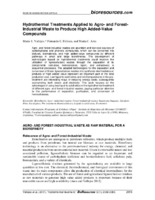Hydrothermal treatments applied to agro- and forest- industrial waste to produce high added-value compounds
Date
2017-01-01Author
Vallejos, María Evangelina
Felissia, Fernando Esteban
Area, María Cristina
Metadata
Show full item recordAbstract
Agro- and forest-industrial wastes are abundant and low cost sources of carbohydrates and phenolic compounds, which can be converted into biofuels, biomaterials, and high added-value compounds by different pathways in small and large biorefineries. The development of technologies based on hydrothermal treatments could improve the utilization of lignocellulosic wastes through the separation of its components (cellulose, hemicellulose, lignin, and extractives) in sequential processes. The adopted technologies for the separation and conversion of these lignocellulosic wastes into synthesis intermediates or products of high added value represent an important part of the total production cost. Low liquid to solid ratios and mild temperatures in the pre-treatment are interesting ways of reducing energy costs, subsequently economizing both steam and electricity. This work focuses on the advantages of using low liquid to solid ratios in the hydrothermal treatment of different agro- and forest-industrial wastes, paying particular attention to the performance of separation, purification, and conversion of hemicelluloses.
Collections
The following license files are associated with this item:




